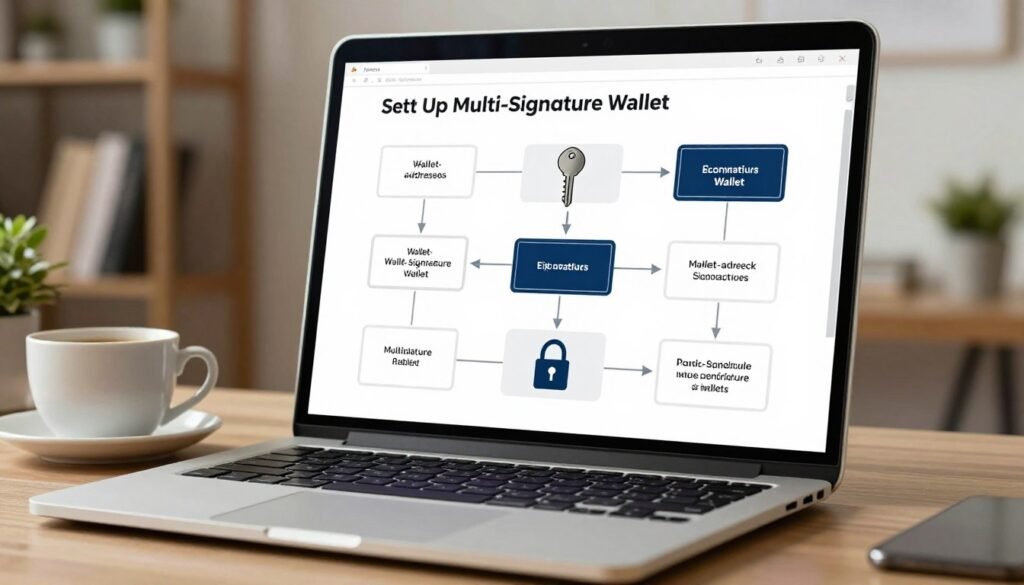Now Reading: The Importance of Crypto Wallet Backup for Security
- 01
The Importance of Crypto Wallet Backup for Security
The Importance of Crypto Wallet Backup for Security

Managing digital currency demands the same vigilance as handling physical cash. Just as you wouldn’t carry large sums unprotected, securing your digital container for Bitcoin requires proactive measures. The freedom to transfer value globally comes with risks—device failures, human error, or theft could erase your holdings permanently.
Unlike traditional banking, decentralized systems place full responsibility on users. There’s no customer service line to recover lost access. Every transaction is irreversible, making prevention your strongest defense. Proper safeguards aren’t optional—they’re the foundation of financial safety in this space.
Imagine misplacing your phone or a hardware malfunction wiping critical data. Without backups, recovering funds becomes impossible. These scenarios highlight why adopting consistent security habits matters from day one. Start by understanding core principles before exploring specific tools.
Key Takeaways
- Digital currency management requires personal accountability, unlike traditional banking systems.
- Irreversible transactions demand robust protection against errors and technical failures.
- Device loss or damage can lead to permanent financial loss without proper safeguards.
- Security practices form the basis for all cryptocurrency storage strategies.
- Backup solutions act as critical insurance against unexpected events.
- Preventive measures significantly reduce risks compared to reactive approaches.
Understanding the Need for a Wallet Backup
Digital asset security hinges on two critical components: private keys and seed phrases. These elements act as gatekeepers to your holdings, with no third-party safeguards available. Unlike traditional accounts, decentralized systems don’t offer password resets or fraud reversal.

The Role of Private Keys and Seed Phrases
A private key is a unique code controlling access to specific blockchain addresses. Each one operates like a digital signature—lose it, and you lose control of associated funds. Seed phrases (12-24 words) serve as master keys, capable of regenerating entire sets of private keys. This hierarchy means securing your phrase protects all addresses in your wallet.
Risks of Losing Digital Assets
Consider these realities:
- One misplaced device or corrupted file can erase access forever
- 20% of Bitcoin’s supply remains locked due to lost keys
- Transactions can’t be canceled or modified after confirmation
The same cryptography enabling secure transfers also creates permanence. Without backups, human errors become financial disasters. Proactive protection isn’t just wise—it’s the only way to ensure long-term asset safety.
Getting Started with Crypto Wallet Backup Procedures
Your first interaction with a storage tool determines long-term security. During activation, systems create a unique sequence of words that becomes your financial lifeline. Treat this moment like safeguarding a house deed—it demands undivided attention.
Initial Setup and Generating Recovery Phrases
New users encounter critical security steps immediately. The system produces 12-24 standardized terms during activation. These secret words rebuild access if devices fail or get damaged. Longer sequences (24 words) offer stronger protection against brute-force attacks.
Selecting the Right Backup Method for Your Needs
Consider these factors when preserving access codes:
- Physical durability: Metal plates survive fires better than paper
- Access frequency: Offline storage reduces hacking risks
- Technical comfort: Encrypted digital copies require tech skills
Hybrid approaches often work best—combine engraved steel with password-protected cloud storage. Test your chosen recovery strategy before storing significant value. Remember: correction opportunities vanish after completing setup.
Crypto Wallet Backup: Methods and Options
Safeguarding virtual holdings demands a strategic approach to storage technology. Two primary systems dominate this space: dedicated physical devices and internet-connected applications. Each offers distinct advantages depending on whether your priority is impenetrable security or everyday accessibility.

Hardware Wallets vs. Software Wallets
Purpose-built devices provide military-grade protection by operating independently from networked systems. These tools generate and store access codes internally, never exposing them to online environments. Their sealed design prevents installation of third-party applications, eliminating common attack vectors.
Application-based alternatives prioritize convenience for regular transactions. However, their connection to internet-enabled devices creates exposure points. Malware or phishing attempts can compromise sensitive data when using these solutions for long-term storage.
Cold Storage and Offline Backup Techniques
For maximum protection, air-gapped methods keep critical information permanently disconnected from digital networks. Steel plates engraved with recovery phrases or paper records stored in fireproof safes exemplify this approach. These physical formats withstand both cyber threats and environmental disasters.
Hybrid strategies often prove most effective. Combine encrypted digital copies with geographically dispersed physical backups. Always test recovery processes before relying on any system—peace of mind comes from verified preparedness.
Enhancing Security with Cold Storage Solutions
Protecting digital assets for decades requires solutions immune to time and disaster. Cold storage methods keep sensitive information completely offline, shielding it from hackers and system failures. This approach prioritizes longevity, ensuring access codes remain intact through fires, floods, or accidental damage.

Using Metal Backups and Paper Solutions
Stainless steel plates offer unmatched durability for preserving recovery phrases. Brands like Material DIY design fireproof and waterproof options that withstand extreme conditions. Unlike paper, these solutions resist fading, tearing, and environmental decay—critical for maintaining legibility over years.
Paper methods pose hidden risks despite their simplicity:
- Ink smudges or discoloration can render words unreadable
- Accidental spills or humidity warp delicate sheets
- Physical copies require climate-controlled environments
Metal alternatives eliminate these concerns through industrial-grade materials. They serve as permanent archives, unaffected by temperature changes or handling errors. For those managing substantial holdings, this reliability justifies the initial investment.
When choosing secure storage methods, consider how often you’ll need recovery access. Offline metal backups work best for long-term protection, while paper remains a temporary option for small balances. Always verify your chosen system’s resilience before relying on it completely.
Step-by-Step Guide to Backing Up Your Wallet
Establishing a reliable access restoration system transforms theoretical security into practical protection. Follow these non-negotiable steps to create failsafe recovery options for your digital holdings.
Preparing Your Device and Recovery Information
Begin by updating your storage software to the latest version. Disconnect from all networks and disable background applications. This creates an isolated environment for generating your master seed phrase—the 12 or 24-word sequence controlling all future access.
Write each term legibly using permanent ink on acid-free paper. For critical holdings, engrave stainless steel plates. Store these materials immediately in a fireproof container. Never photograph or type your phrase—digital copies create attack vectors.
Verifying and Testing Your Backup
Conduct three verification checks:
- Compare written words against the original display—character by character
- Practice recovery on a secondary device using only your backup
- Confirm successful transaction signing after restoration
This process exposes errors before real funds are at risk. Treat successful verification as mandatory—like testing smoke detectors annually. Proper execution turns fragile digital access into durable financial control.
Best Practices for Managing Recovery and Private Keys
Securing digital assets starts with unbreakable access codes and strategic redundancy. While blockchain technology offers financial sovereignty, it demands meticulous planning to prevent irreversible losses. Let’s explore essential protocols for maintaining control over your holdings.
Creating Strong Passwords and Encryption Methods
Traditional banking systems allow password resets—blockchain systems don’t. Your access codes must combine complexity with memorability. Follow these guidelines:
- Use 16+ characters mixing uppercase, symbols, and numbers
- Avoid dictionary words or personal references
- Generate codes through trusted password managers
Encrypt sensitive files like recovery phrases using AES-256 standards. Test decryption processes regularly to avoid technical lockouts. Remember: complexity without usability creates new risks.
Storing Backup Data in Multiple Secure Locations
Geographic diversity protects against localized disasters. Split your recovery materials across:
- Fireproof home safes
- Bank deposit boxes
- Trusted relatives’ secure storage
Never store digital copies on internet-connected devices. For critical holdings, combine metal plate engravings with tamper-evident bags. Update storage arrangements annually to address life changes or new threats.
Addressing Common Backup and Recovery Mistakes
Digital protection requires recognizing both technical risks and human error patterns. Even experienced users often undermine their security through seemingly harmless shortcuts.
Identifying and Avoiding Digital Vulnerabilities
Capturing recovery phrases through screenshots or phone cameras creates permanent vulnerabilities. These digital traces expose your assets to malware or unauthorized network access. Once uploaded to a cloud service or email, the information becomes searchable across multiple devices.
Storing sensitive data on internet-connected computers magnifies risks. Hackers frequently target personal apps and software vulnerabilities. A single compromised network session could lead to irreversible financial loss.
Physical separation matters as much as digital security. Keep recovery materials far from primary storage devices. Shared locations create single points of failure during theft or disasters.
Always verify storage methods through trial recoveries. This practice reveals flaws before real funds are at stake. Treat security protocols like muscle memory—consistent habits prevent catastrophic mistakes.
FAQ
Why are private keys and seed phrases critical for accessing funds?
Private keys and seed phrases act as master passwords to your digital holdings. Losing them means permanent loss of access. Services like Ledger or Trezor rely on these codes to restore holdings, so storing them securely offline is non-negotiable.
What risks come with mishandling recovery information?
Exposure to hackers, accidental deletion, or physical damage can erase holdings forever. Without proper storage, you risk losing assets due to device failure, theft, or human error. Always use encrypted methods and avoid digital platforms like email for storage.
How do I begin securing my holdings using recovery tools?
Start by generating a recovery phrase during setup. Write it on paper or etch it into metal. Avoid screenshots or cloud storage. Tools like Exodus or MetaMask guide users through this process, emphasizing offline storage for maximum safety.
Are hardware devices safer than software apps for storing funds?
Hardware wallets like Trezor or KeepKey keep keys offline, blocking remote hacks. Software apps are convenient but face higher cyberattack risks. For large holdings, combining both with cold storage adds layers of protection.
How does cold storage prevent unauthorized access?
Cold storage keeps recovery data entirely offline, away from internet threats. Options like engraved steel plates or paper in a safe resist fire, water, and physical wear. This method ensures long-term durability against accidents.
What steps verify if a backup works properly?
After creating a backup, test recovery on a separate device using the seed phrase. Confirm access to addresses and transaction history. Regularly update backups when adding new assets or changing passwords.
Why store recovery details in multiple locations?
Diversifying storage (e.g., home safe + bank vault) guards against localized disasters. Use tamper-proof containers and share access only with trusted individuals. Never keep all copies in one place, even if encrypted.
What mistakes compromise security during backup creation?
Common errors include weak passwords, reusing phrases across platforms, or skipping encryption. Avoid typing phrases on unsecured networks and never disclose them. Use tools like AES-256 encryption for digital backups.













